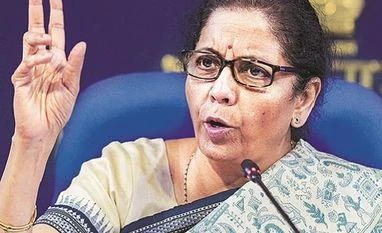The lower minimum alternate tax (MAT) rate announced as part of the corporation tax rate cuts in September will be applicable from the current fiscal year (2019-20 or FY20), Finance Minister Nirmala Sitharaman clarified on Monday in the Lok Sabha after an error in the Taxation Amendment Bill spooked companies.
For the second time in less than a week, Sitharaman also spoke of the challenges in maintaining fiscal discipline, while comparing the Modi government’s fiscal record with that of the Manmohan Singh government. Sitharaman said a final call on the fiscal deficit will be taken at the Revised Estimate stage.
The Taxation Law Amendment Bill, 2019 was introduced and passed in the Lok Sabha on Monday. It had said the lower MAT rate of 15 per cent, down from 18.5 per cent, will be applicable from the next financial year (2020-21 or FY21), while the Ordinance had said the lower rate will be effective from the current financial year. The corrections were made by way of an official amendment, changing FY21 to assessment year 2020-21.
“The intention has always been to apply reduced MAT rate from the year 2019-20. That error will be corrected through an official amendment now. The original intent was to apply it from 2019-20, which continues to be the case now,” said Sitharaman. In order to promote growth and investment and attract fresh investment in the manufacturing sector, the government through an Ordinance provided domestic companies with an option to pay tax at the rate of 22 per cent if they do not claim deductions and exemptions.
Besides the corporation tax rate was cut to 15 per cent for new manufacturing companies set up after October 1, 2019, without any deduction or exemptions and start manufacturing before April 1, 2023.
Finally, the MAT rate was lowered to 15 per cent from 18.5 per cent for companies that continued to claim exemptions. MAT is the minimum amount of tax required to be paid by a company, in case its normal tax liability after claiming deductions falls below a certain limit. MAT credit will also not apply to companies opting for the new rates.
“The government has corrected the mismatch in the dates on the applicability of MAT rate and has made it in consonance with the date given in the ordinance” said Rakesh Nangia, managing partner, Nangia Andersen Consulting.
“The lower MAT rate will be applicable from April 1, 2019, which is indeed a welcome step. This had caused lot of confusion,” he added. Regarding fiscal deficit, Sitharaman said, “I fully appreciate the concerns that the honourable members have raised regarding the fiscal deficit, that what happens to fiscal deficit as there is revenue foregone of Rs 1.45 trillion because of the corporation tax cuts. Yes, I am aware of those concerns. We will take a final decision on the fiscal deficit at the Revised Estimates stage.”
Allaying fears of corporate tax reduction impacting revenue collection, Sitharaman said gross direct tax collection increased by 5 per cent till November. Historically, maximum collection of direct taxes happens in the last quarter of the fiscal, she added. Sitharaman said the average fiscal deficit under the UPA-II government was 5.5 per cent, while during the Modi government’s first term was 3.68 per cent of gross domestic product.
“We have managed to keep fiscal discipline completely intact and maintained the average fiscal deficit well under 4 per cent,” she said.
Unlock 30+ premium stories daily hand-picked by our editors, across devices on browser and app.
Pick your 5 favourite companies, get a daily email with all news updates on them.
Full access to our intuitive epaper - clip, save, share articles from any device; newspaper archives from 2006.
Preferential invites to Business Standard events.
Curated newsletters on markets, personal finance, policy & politics, start-ups, technology, and more.
)